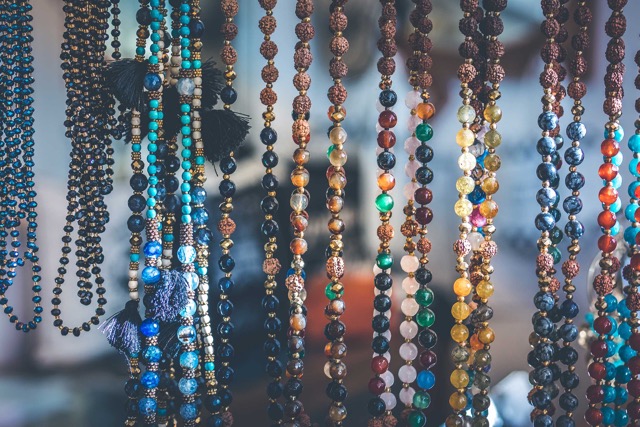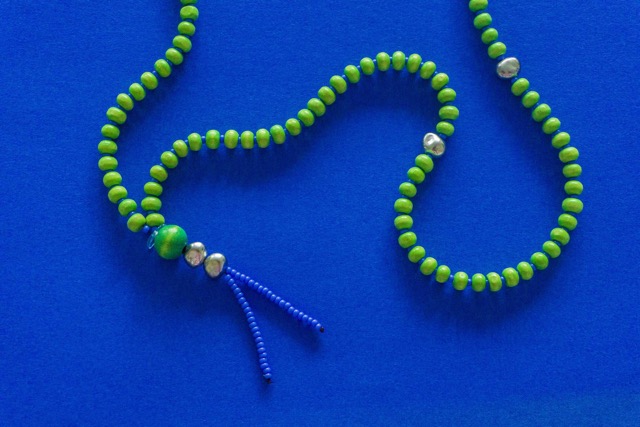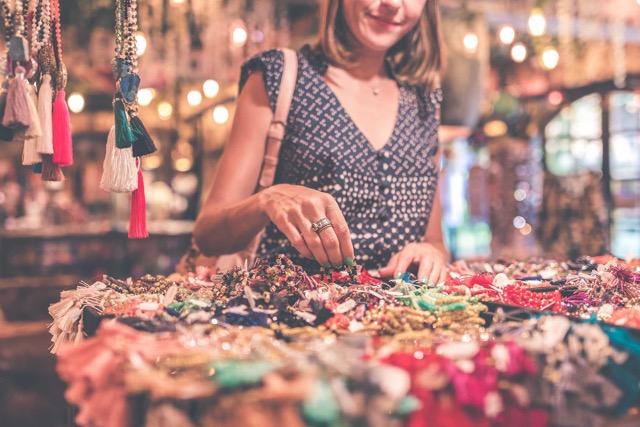You might see your yoga teacher or hippie friend wearing a mala, but did you know that the mala has a very revered significance and can be used to transcend space and time?
And most importantly, it has 108 beads. But why does the mala have 108 beads? That question has some very interesting answers.
Read on to find out everything you need to know about the mala and why it has 108 beads.
What Are Mala Beads?
“Mala” means “garland” in Sanskrit, the ancient Indian language that is still used in yoga classes today. Usage of the mala, also called Japa mala beads, goes back to the 8th century BC.
A Mala consists of 108 beads plus one guru or Meru bead at the center that usually carries the tasel and represent a lotus flower. The guru bead is typically larger than the rest of the beads and is said to represent a teacher, who has given the student a mantra.
Beads are usually of natural origin, wood or stone. Many people these days like to actually wear a mala as jewelry, on the neck or the wrist.
Mala or Japa beads are used in Hinduism, Buddhism, Jainism, and Sikhism. “Japa” means “to utter” in Sanskrit, referring to the way mala beads are used to repeat a mantra over and over.
How To Use The Mala Beads
Mala or Japa beads are used primarily for meditation or spiritual work. The most traditional way to use Mala beads is by grasping the first mala bead just after the guru bead between your index and thumb fingers, then proceeding by saying a prayer, sound, or mantra. Continue this process with each bead on the Mala.
This brings about peace and calm and can also help you focus. It is a great way to elevate your practice and also a good place for beginners to dive into mediation.
Here’s a play by play on how to use mala beads for your meditation practice.
- Sit in a quiet space, traditionally in Sukasana (easy pose) with the spine erect.
- Close your eyes and steady the breath in and out through the nose.
- Carry your Mala in your right hand.
- Grasp the Meru (The largest bead marking the end or beginning of the mala, also called the guru bead,) between your fingers and start your mantra, continue on to the next bead and repeat the mantra.
- Continue until you reach the Meru again.
- Repeat as many times as you like.
How To Wear Mala Beads
In some traditions, it is said if a person wears a mala above their shirt and out in public, they are proclaiming they are a possesor of knowledge.
These days you will find many spiritual folks wearing a mala around the neck or on their wrist. You can wear a mala on your wrist by wrapping it a few times until the mala fits snuggly.
Feel free to wear your mala on either wrist as Tibetan Buddists wear a mala on either their right or left wrists depending on personal preference.
Wearing a mala can remind you throughout the day to stay peaceful and mindful, just like you feel when you sit down to meditate with your mala.
Some people claim that a mala should never touch the floor, and if it does it should be gently cleansed. You can wash it wish a gentle soap. You may also try charging it with cleansing crystals to bring it’s powers back into alignment.
There are other superstitions that indicate no one besides the owner should touch the mala, as this will tarnish or decrease its energies.

Bracelets Malas Vs. Necklace Malas
There is actually a short mala that can be worn specifically around the wrist. These are called Bracelets Malas or Wrist Malas.
A wrist mala typically has 18, 21, or 27 beads depending on the size. Just like a necklace mala, a bracelet mala will have a guru bead.
These smaller malas can be used in the same fashion as a full-size mala. You remove the mala from your wrist during meditation to recite mantras. The mala being on the wrist makes for easy access.
Wearing the bracelet mala can also be a reminder for you to stay focused and centered in your daily life.
Related Posts: Breakthrough Mantras For Transcendental Meditation 🙏
Why You Are Missing Out On Yoga Nidra For Sleep 😴
History of Mala Beads & Indian Culture
During the 8th century BCE in ancient India is when the first appearance of prayer beads for mediation appeared. Since then many religions like Buddism, Jainism, and Christianity have incorporated their own version of a Mala or prayer bead necklace.
The significance of the number 108 appeared in India during the Vedic Culture (c. 1500 – c. 500 BCE,) and many of our current yoga traditions spawn from this very time. People of the Vedic culture follow the Hindu religion.
The Hindu religion is a polytheistic religion in which the worshiper prays to many different gods, in this case, hundreds (some believe there are 108 Hindu gods and goddesses.) Familiar deities like Vishnu, Shiva, Lakshmi, and Deva are from the Hindu Religion.
To find out the origins of 108, we have several ancient texts to point us in the right direction. The Upanishads is a sacred text written during the Vedic Period which is a book that is still revered today. In it, there are 108 Upanishads.
There is also a Buddhist text from the 4th century BC called the Mokugenji Sutra in which Buddha instructs his follower with this quote:
The Buddha replied: “King, if you want to eliminate earthly desires, make a circular string of 108 wooden beads. Hold them always to yourself. Recite ‘Namu Buddha-Namu Dharma-Namu Sangha’; Count one bead with each recitation.”

10 Mysteries Of The Sacred Number 108 ( The Last Few Are INSANE!)
Many people wonder, why does the mala have 108 beads? There are some surprising reasons for this. The mala actually has 109 beads, 108 beads plus the center guru bead.
- There are said to be 108 energy lines converging on the Heart Chakra (Anahata.) Of them is Sushumna which leads directly to the Crown Chakra (Sahasrara) facilitating a path to higher consciousness.
- Both 9 and 12 are believed to have importance in many cultures. 9 times 12 = 108. Pregnancy lasts 9 months, and there are 12 months in the year. There are also 12 astrological signs and 9 planets if you include Pluto!
- There are 108 letters in the Sanskrit Alphabet, each letter being either masculine or feminine, shiva and shakti. 54 times 2 = 108.
- Many religions revere 108. In Islam, 108 is a number used to refer to God.
- Buddhists believe there are 108 virtues and 108 defilements to avoid. Buddhists are known to ring a bell 108 times to celebrate a new year or carve 108 Buddhas for good luck.
- In Hebrew, the word chai, “life” or “alive,” is represented by the 18, which is a multiple of 108.
- Chinese astrology says that there are 108 sacred stars.
- The angle formed by two adjacent lines in a pentagon equals 108 degrees. Pentagons and pentagrams are considered sacred geometry.
- The Atman, (“self” or “breath” in Sanskrit) meaning universal self, is thought to go through 108 stages on its journey in Hinduism.
- In astrology, the moon is represented by the metal Silver. The atomic weight of silver is 108.
- The diameter of the Sun is 108 times the diameter of the Earth. The distance from the Sun to the Earth is 108 times the diameter of the Sun.
- The distance from the Moon to the Earth is 108 times the diameter of the Moon. This is why we are able to view magnificent perfect solar eclipses.
- The first space flight by a human was made by Yuri Gagarin on April 12, 1961. His space flight lasted a total of 108 minutes in which he completed one orbit of Earth.

Why You Should Have a Mala
It is said that carrying a mala or having one near you has a calming effect, and is a constant reminder of your desire to achieve enlightenment. Or at least have a regular meditation practice!
Purchase a mala made from good materials and preferabbbly made by hand. Keep it near your personal yoga space or on your altar. Make time to practice with your mala either before or after each of your yoga practices.
Do you use a mala for mediation? Tell us about in the comments!



0 Comments